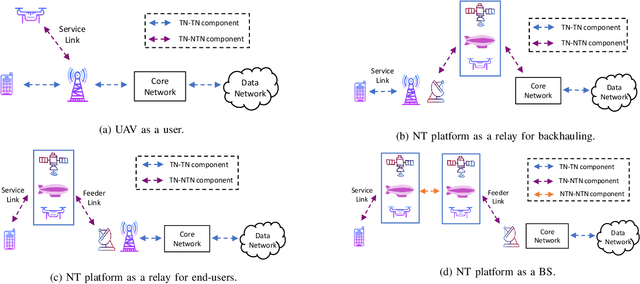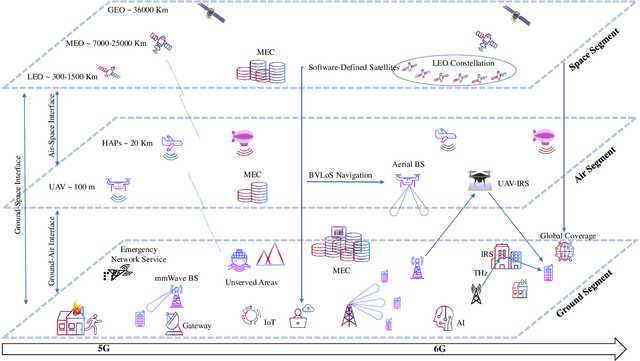Arsham Mostaani
Joint Source-Channel Coding System for 6G Communication: Design, Prototype and Future Directions
Oct 02, 2023Abstract:The goal of semantic communication is to surpass optimal Shannon's criterion regarding a notable problem for future communication which lies in the integration of collaborative efforts between the intelligence of the transmission source and the joint design of source coding and channel coding. The convergence of scholarly investigation and applicable products in the field of semantic communication is facilitated by the utilization of flexible structural hardware design, which is constrained by the computational capabilities of edge devices. This characteristic represents a significant benefit of joint source-channel coding (JSCC), as it enables the generation of source alphabets with diverse lengths and achieves a code rate of unity. Moreover, JSCC exhibits near-capacity performance while maintaining low complexity. Therefore, we leverage not only quasi-cyclic (QC) characteristics to propose a QC-LDPC code-based JSCC scheme but also Unequal Error Protection (UEP) to ensure the recovery of semantic importance. In this study, the feasibility for using a semantic encoder/decoder that is aware of UEP can be explored based on the existing JSCC system. This approach is aimed at protecting the significance of semantic task-oriented information. Additionally, the deployment of a JSCC system can be facilitated by employing Low-Density Parity-Check (LDPC) codes on a reconfigurable device. This is achieved by reconstructing the LDPC codes as QC-LDPC codes. The QC-LDPC layered decoding technique, which has been specifically optimized for hardware parallelism and tailored for channel decoding applications, can be suitably adapted to accommodate the JSCC system. The performance of the proposed system is evaluated by conducting BER measurements using both floating-point and 6-bit quantization.
Task-Oriented Communication Design at Scale
May 15, 2023



Abstract:With countless promising applications in various domains such as IoT and industry 4.0, task-oriented communication design (TOCD) is getting accelerated attention from the research community. This paper presents a novel approach for designing scalable task-oriented quantization and communications in cooperative multi-agent systems (MAS). The proposed approach utilizes the TOCD framework and the value of information (VoI) concept to enable efficient communication of quantized observations among agents while maximizing the average return performance of the MAS, a parameter that quantifies the MAS's task effectiveness. The computational complexity of learning the VoI, however, grows exponentially with the number of agents. Thus, we propose a three-step framework: i) learning the VoI (using reinforcement learning (RL)) for a two-agent system, ii) designing the quantization policy for an $N$-agent MAS using the learned VoI for a range of bit-budgets and, (iii) learning the agents' control policies using RL while following the designed quantization policies in the earlier step. We observe that one can reduce the computational cost of obtaining the value of information by exploiting insights gained from studying a similar two-agent system - instead of the original $N$-agent system. We then quantize agents' observations such that their more valuable observations are communicated more precisely. Our analytical results show the applicability of the proposed framework under a wide range of problems. Numerical results show striking improvements in reducing the computational complexity of obtaining VoI needed for the TOCD in a MAS problem without compromising the average return performance of the MAS.
Evolution of Non-Terrestrial Networks From 5G to 6G: A Survey
Jul 14, 2021



Abstract:Non-terrestrial networks (NTNs) traditionally had certain limited applications. However, the recent technological advancements opened up myriad applications of NTNs for 5G and beyond networks, especially when integrated into terrestrial networks (TNs). This article comprehensively surveys the evolution of NTNs highlighting its relevance to 5G networks and essentially, how it will play a pivotal role in the development of 6G and beyond wireless networks. The survey discusses important features of NTNs integration into TNs by delving into the new range of services and use cases, various architectures, and new approaches being adopted to develop a new wireless ecosystem. Our survey includes the major progresses and outcomes from academic research as well as industrial efforts. We first start with introducing the relevant 5G use cases and general integration challenges such as handover and deployment difficulties. Then, we review the NTNs operations in mmWave and their potential for the internet of things (IoT). Further, we discuss the significance of mobile edge computing (MEC) and machine learning (ML) in NTNs by reviewing the relevant research works. Furthermore, we also discuss the corresponding higher layer advancements and relevant field trials/prototyping at both academic and industrial levels. Finally, we identify and review 6G and beyond application scenarios, novel architectures, technological enablers, and higher layer aspects pertinent to NTNs integration.
Task-Based Information Compression for Multi-Agent Communication Problems with Channel Rate Constraints
May 28, 2020



Abstract:A collaborative task is assigned to a multiagent system (MAS) in which agents are allowed to communicate. The MAS runs over an underlying Markov decision process and its task is to maximize the averaged sum of discounted one-stage rewards. Although knowing the global state of the environment is necessary for the optimal action selection of the MAS, agents are limited to individual observations. The inter-agent communication can tackle the issue of local observability, however, the limited rate of the inter-agent communication prevents the agent from acquiring the precise global state information. To overcome this challenge, agents need to communicate their observations in a compact way such that the MAS compromises the minimum possible sum of rewards. We show that this problem is equivalent to a form of rate-distortion problem which we call the task-based information compression. We introduce two schemes for task-based information compression (i) Learning-based information compression (LBIC) which leverages reinforcement learning to compactly represent the observation space of the agents, and (ii) State aggregation for information compression (SAIC), for which a state aggregation algorithm is analytically designed. The SAIC is shown, conditionally, to be capable of achieving the optimal performance in terms of the attained sum of discounted rewards. The proposed algorithms are applied to a rendezvous problem and their performance is compared with two benchmarks; (i) conventional source coding algorithms and the (ii) centralized multiagent control using reinforcement learning. Numerical experiments confirm the superiority of the proposed algorithms.
 Add to Chrome
Add to Chrome Add to Firefox
Add to Firefox Add to Edge
Add to Edge